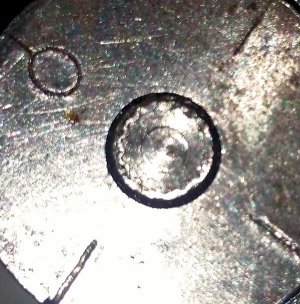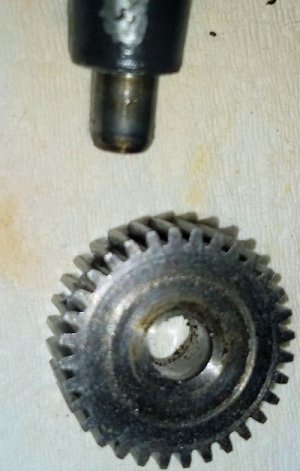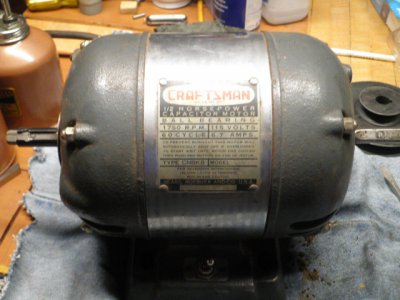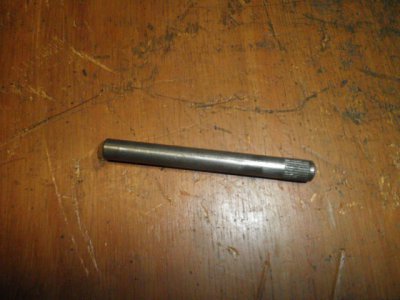-
Welcome back Guest! Did you know you can mentor other members here at H-M? If not, please check out our Relaunch of Hobby Machinist Mentoring Program!
You are using an out of date browser. It may not display this or other websites correctly.
You should upgrade or use an alternative browser.
You should upgrade or use an alternative browser.
12" Atlas Reverse Tumbler Gear Stud
- Thread starter paul s
- Start date
- Joined
- Dec 25, 2011
- Messages
- 10,552
The lower gear looks to have the tips of the teeth worn a little bit.
If the Locktite treatment doesn't appear to work, you could mount the bushing on an expanding mandrel and run a knurling tool over it lightly to increase the effective OD 2 or 3 thou.
If the Locktite treatment doesn't appear to work, you could mount the bushing on an expanding mandrel and run a knurling tool over it lightly to increase the effective OD 2 or 3 thou.
I wonder if this design changed over the years. I don't recall having to take the dial off to get the shaft out, but then again it has been so long I don't even remember if mine was knurled on the gear end or if the knurl was just a snug fit going through the bore.Yes. But no one that I know of has reported as to whether or not the top of the shaft is also knurled.
- Joined
- Dec 25, 2011
- Messages
- 10,552
The gear and the dial on my 3996 are pressed onto the shaft. But I do not know whether either end of the shaft is knurled. I don't know how other than a press fit you would hold either one in place. The shaft itself is much too small for any available key type. As to how it was done on earlier machines, I have to admit that I happen to own the newest lathe in the database. I bought it in early 1981, just before production ceased. But I don't think that the part numbers of the three parts ever changed.
I would try carefully tapping the shaft out of the dial. Tap it until it just barely starts to come out of the dial and check and see if it feels like it is binding when you rotate it. If not, tap a little farther out and check again. Rinse and repeat. If it feels like it is binding stop and see if you have gained enough of a gap between the dial and the body to see if the shaft is knurled.
On the 6" lathe it is just the opposite, the dial end is knurled(splined) and the gear end is smooth.


On the 6" lathe it is just the opposite, the dial end is knurled(splined) and the gear end is smooth.


- Joined
- Dec 25, 2011
- Messages
- 10,552
OK. That;s useful to know.
Yes, the dial has to go on last. If you have a drill press, I would suggest chucking the shaft in its chuck and using the quill down feed to try to get the shaft started into the gear straight. If you can see the spline marks in the bore of the gear, try to align the splines an the shaft with thise in the gear. Then use a press, not a hammer, to push the shaft into the gear. When you put the dial on the other end, leave about 0.005" end float.
Ideally, when you get the dial back on, using the "1" mark as the reference, it should be misaligned with the witness mark by the same amount when running the carriage toward the headstock as when running it toward the tailstock, but of course on the opposite side of the mark.
Yes, the dial has to go on last. If you have a drill press, I would suggest chucking the shaft in its chuck and using the quill down feed to try to get the shaft started into the gear straight. If you can see the spline marks in the bore of the gear, try to align the splines an the shaft with thise in the gear. Then use a press, not a hammer, to push the shaft into the gear. When you put the dial on the other end, leave about 0.005" end float.
Ideally, when you get the dial back on, using the "1" mark as the reference, it should be misaligned with the witness mark by the same amount when running the carriage toward the headstock as when running it toward the tailstock, but of course on the opposite side of the mark.
Only the gear end is knurled. I suppose I have to re-index this on the lathe?
To index it, after you have the gear back on the shaft place the assembly back on the lathe and engage the halfnuts. Then just push the dial on enough with your fingers to hold its position with the marks aligned. Remove the assembly and finish pressing on the dial. (Squeeze in a vise if you don't have a press)
As wa5cab said, make sure you leave a little clearance. There are no shoulders on the shaft so if you press it together too tight it will bind.
OK - I've got the apron, the cross slide, the compound, the banjo/gears, the headstock, and the tailstock back together, cleaned and lubed - I'm in the home stretch.
I'll attach a picture of the motor - is this original to the machine? It's got a cord and plug coming out of it, a switch at it's base - looks more like something from a bench grinder. The shaft is 1/2" diameter, the pulley (10-428) is 5/8" bore, with an adapter on the motor shaft that looks home made. The headstock has an on/off switch. I don't care about being able to reverse it, so how would this have been wired originally? I also noticed the PN of the pulley in my pdf is 9-428.
I'll attach a picture of the motor - is this original to the machine? It's got a cord and plug coming out of it, a switch at it's base - looks more like something from a bench grinder. The shaft is 1/2" diameter, the pulley (10-428) is 5/8" bore, with an adapter on the motor shaft that looks home made. The headstock has an on/off switch. I don't care about being able to reverse it, so how would this have been wired originally? I also noticed the PN of the pulley in my pdf is 9-428.


